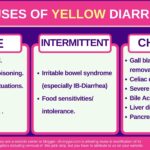7 Causes of Sand-like stool in adults & When to worry.
Our content is not intended nor recommended as a substitute for medical advice by your doctor. Use for informational purposes only.
Quick Summary:
Common causes of sand-like stool include:
- Dietary changes such as overeating fruits, dairy products, or fatty meals.
- Food intolerances such as lactose or FODMAP intolerance.
- Irritable bowel syndrome.
- Acute or chronic infections of the digestive system.
- Medications such as metformin, laxatives, stomach ulcer medications, etc.
- Celiac disease.
- Others include chronic pancreatitis, anxiety, stress, bile acid diarrhea, etc.
In this article, we will break down each of the common causes, their features, and how the condition is diagnosed.
1 . Changes in your dietary habits.
Dietary changes are the most common cause of transient or recurrent sand-like stools in adults. Your digestive system cannot tolerate some dietary changes when you eat certain foods in excess.
For example, fructose (mainly in fruits and honey) may make your stool loose and yellow and disintegrate easily in the toilet (like sand).
Common dietary triggers of the sand-like stool are :
- A large fatty meal.
- Consuming too much milk, ice cream, yogurt, or other dairy products.
- Eating too much fructose or sorbitol-containing fruits such as apples and bananas.
- Drinking too much alcohol.
- coffee and caffeinated drinks
- Sugar substitutes such as aspartame.
- Garlic and onion.
- Broccoli and cauliflower.
- Spicy food.
These foods make the stool softer by drawing more water into the digestive tract, speeding up bowel movements, or adding bulk to the stool.
The effect of diet on your stool depends largely on the amount you eat. Eating in moderation often doesn’t lead to any problems (unless you have real food intolerance).
The sand-like stool appears when you consume excessive amounts of specific foods beyond your digestive system’s capacity. For example, eating five apples in one day instead of one or two may cause loose or sand-like stool.
The diet-indued stool changes due to faulty habits are often being, self-limiting and resolve shortly after you cut the offending food or food habit.
Learn more about common foods that cause diarrhea.
2. Food intolerance or allergy.
Food intolerance occurs when your digestive system finds difficulty in digesting certain types of food or food components.
As a result, these foods accumulate in the digestive tract, acted upon by the gut bacteria, leading to gas, cramps, bloating, and other symptoms of food intolerance.
Also, undigested foods draw water into the digestive tract, often leading to loose stool or diarrhea that disintegrates easily in the toilet. The poop color may turn light brown or yellow, giving it a sand-like appearance.
Food intolerance is common, It is estimated that 15-20% of people have some food intolerance.
Common forms of food intolerance are:
- Lactose intolerance: found in milk, ice cream, yogurt, and other dairy products.
- Fructose intolerance: found in most fruits and honey.
- Gluten intolerance (in celiac disease): found in wheat, rye, and barley. Celiac disease is explained separately below.
- Caffeine intolerance.
- FODMAP intolerance: FODMAPs are a group of short-chain, rapidly fermentable carbohydrates found in various foods (illustrated in the table below). They are a common cause of diarrhea and sand-like stools in people with IBS.
- And others.
| Sugar type | Foods containing | ||
|---|---|---|---|
| F | Fermentable | ||
| O | Oligosaccharides | Fructans, galactooligosaccharides | Wheat, barley, rye, onion, leek, the white part of spring onion, garlic, shallots, artichokes, beetroot, fennel, peas, chicory, pistachio, cashews, legumes, lentils, chickpeas |
| D | Disaccharides | Lactose | Milk, custard, ice cream, and yogurt |
| M | Monosaccharides | “Free fructose” | Apples, pears, mangoes, cherries, watermelon, asparagus, sugar snap peas, honey, high-fructose corn syrup |
| A | And | ||
| P | Polyols | Sorbitol, mannitol, maltitol, and xylitol | Apples, pears, apricots, cherries, nectarines, peaches, plums, watermelon, mushrooms, cauliflower, artificially sweetened chewing gum, and confectionery |
On the other hand, food allergy is an immune-mediated response to certain foods which can produce intestinal symptoms (stool changes, diarrhea, colics, nausea) and other allergic symptoms such as rashes, swollen lips, etc.
The table below illustrates the differences between food intolerances and food allergies:
| Food intolerance | Food allergy |
|---|---|
| Affects 15-20% of the population | Affects nearly 2-5% of adults |
| Difficulty digesting certain types of food (not immune-mediated allergy). | An immune-mediated reaction to certain foods or food components. |
| Causes “recurrent acute” or “chronic” attacks of diarrhea, so much gas, and bloating. | Usually causes acute attacks related to the ingestion of offending food. |
| Intestinal symptoms: diarrhea, extensive gas, bloating, distension, and abdominal pain. Also, nausea and sick feeling are common after eating. | Intestinal symptoms are the same. |
| No extraintestinal symptoms | Extraintestinal symptoms like rashes, urticaria, swollen lips or face, or severe life-threatening allergic reactions. |
| The severity of your symptoms is proportional to the amount you eat from the offending food. | Even trace amounts of the offending food can produce severe symptoms. |
| Common offending foods: | |
| • Lactose intolerance (dairy products). | |
| • Fructose malabsorption. | |
| • Alcohol intolerance. | |
| • FODMAP intolerance (as with People with IBS). | Common offending foods: (examples) |
| • Raw meat and seafood. | |
| • Nuts, peanut | |
| • Mustard. | |
| • Rice | |
| • Some vegetables and fruits |
3. Irritable bowel syndrome.
Irritable bowel syndrome affects too many people worldwide. Approximately 10 to 15% of people have IBS (reference).
Surprisingly, Too many people who match the criteria of IBS don’t seek medical advice. Some studies estimated that 60% of people with IBS symptoms don’t know they have the disease! (reference).
IBS has four subtypes according to the predominant symptom. What concerns us today is the diarrhea-predominant IBS. Diarrhea-predominant IBS may present with sand-like (yellow and loose) stools.
Symptoms (how to suspect IBS-diarrhea):
- Abdominal pain is the main symptom of IBS. IBS sufferers should experience abdominal pain at least one day per week for the past three months.
- The abdominal pain either improves or worsens after the bowel movement.
- The onset of abdominal pain is associated with constipation, diarrhea, or loose (sand-like) stool (change in stool form).
- Gas and bloating are frequent in people with IBS.
- Loss of appetite.
- Mucus in the stool.
The IBS is usually triggered by:
- Certain foods, such as FODMAPs.
- Alcohol and caffeine.
- Fatty foods and spicy foods.
- Stress and anxiety.
If you suspect IBS is a cause of constant diarrhea. Learn how IBS is diagnosed in this in-depth article.
4. Infections of the digestive system.
Infection is the most common cause of the ACUTE onset of loose or watery yellow stools that may look like sand.
Gut bugs such as viruses, bacteria, and protozoa may invade your small intestine and the colon causing digestive symptoms such as diarrhea with mucus discharge, abdominal pain, and flatulence.
For Example:
- Acute viral gastroenteritis (stomach flu).
- Most types of foodborne illnesses (food poisoning).
- Also, chronic causes of intestinal infections may lead to sand-like stools, such as chronic giardiasis.
Symptoms of gastroenteritis:
- Acute digestive tract infections cause acute onset diarrhea with mucus discharge (loose or watery stool with mucus).
- The diarrhea is often watery or loose, yellowish in color, and disintegrates easily in the toilet.
- Abdominal pain (Belly pain).
- Nausea or vomiting.
- Low-grade fever and body aches (however, bacterial gastroenteritis may cause high-grade fever).
- The symptoms of acute diarrhea and abdominal cramps are often short and resolve within a few days.
- Chronic infections may also cause chronic diarrhea and sand-like stool. Giardiasis may induce weight loss.
5. Celiac disease.
Celiac disease is an extreme form of food allergy. The intolerance to a protein called gluten results in severe intestinal inflammation and interferes with the absorption of various nutrients.
Gluten is present in:
- Wheat-based food (such as bread).
- Rye.
- Barley.
Celiac disease is a relatively common condition. It affects about 1.4% of people worldwide (reference).
Symptoms:
- The usual age of onset is between 20-30 years of age. But it can occur in older generations up to 70 years.
- Abdominal pain and bloating.
- Diarrhea or mushy stool with gas.
- Celiac disease stool is often loose, yellowish, foul-smelling, and floats on water. You can learn more about celiac disease stool changes in this article.
- Diarrhea can also be intermittent or not present.
- Constipation can also occur.
- Nausea and vomiting.
- Weight loss.
- Easy fatigue and iron deficiency anemia.
- Itchy, blistery skin.
- Osteoporosis and osteomalacia (body aches).
Celiac disease is diagnosed by a blood test or biopsy of the small intestine. People with celiac disease often improve when they eliminate gluten from their diet.
6. Medications
Medications are often overlooked as a cause of diarrhea or loose stool. Many drugs can result in digestive problems such as abnormal stool forms (loose or sand-like stools)
Please review your list to avoid medications that can cause mushy stool and gas.
Common medications that commonly cause diarrhea or loose (or sand-like) stools:
- Metformin and gliptins (anti-diabetes medications).
- Antibiotics: particularly penicillins and cephalosporins.
- Laxative overuse.
- Stomach/GERD medications: especially Proton Pump Inhibitors such as Omeprazole (Prilosec), Esomeprazole (Nexium), and Pantoprazole (Protonix).
- Antidepressants such as Citalopram (Celexa) and Escitalopram (Lexapro).
- Chemotherapy.
- Non-steroidal anti-inflammatory drugs: such as Ibuprofen (Advil).
- Cholcicine (Colcrys, Mitigare).
- Some anti-hypertensive medications include Enalapril (Vasotec) and Lisinopril (Zestril, Prinivil).
- More than 700 medications can cause diarrhea or loose stool: The list is HERE and HERE.
7. Other causes of sand-like stools.
- SIBO (Small intestinal bacterial overgrowth).
- Acute or chronic stress and anxiety.
- Colorectal cancer.
- Chronic pancreatitis.
- Bile acid diarrhea.
- Endocrinal diseases such as hyperthyroidism, carcinoid, and neuroendocrinal tumors.
When to worry about sand-like stool?
See a doctor if you have:
- Persistent loose stool or diarrhea like sand without obvious cause.
- Recurrent nausea or vomiting.
- Severe epigastric pain or heartburn.
- Fever.
- Vomiting of blood.
- Black stools.
- Blood in the stool.
- Significant loss of weight.
- Taking any medications that cause diarrhea.
- Evidence-based
- Written by a doctor.

Related Posts:
- Stomach Pain after Emptying the Bladder: Causes…
- Tea-colored Urine: 5 Main Causes & When to Worry
- Fluffy Poop: 7 Causes & When to Worry (Doctor Explains).
- Clear Urine with Bubbles: 6 Main Causes & When to Worry
- 7 Stomach Cancer Symptoms in Women & When To Worry.
- 5 Gallbladder Symptoms in Men& When to Worry…






